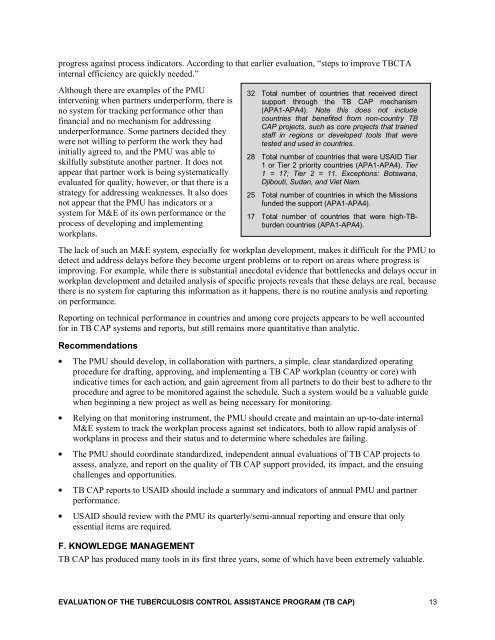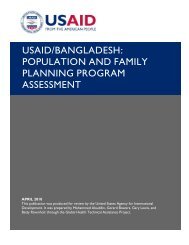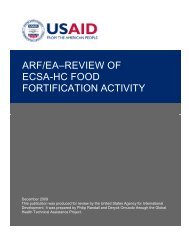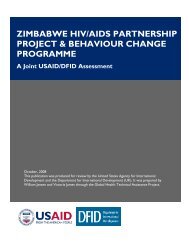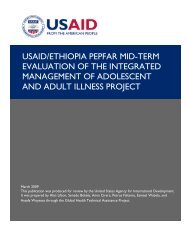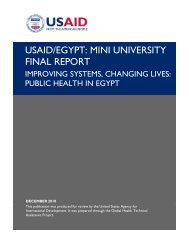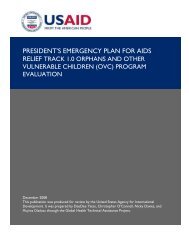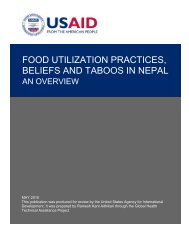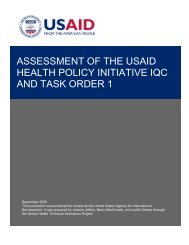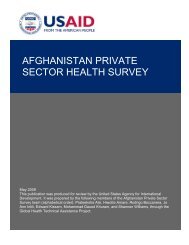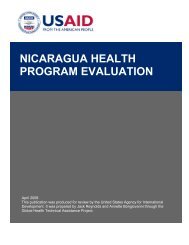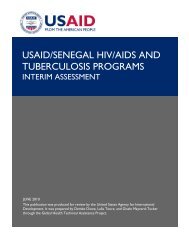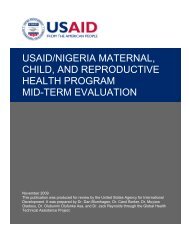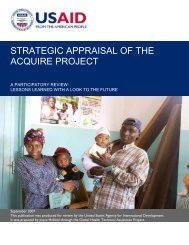The PMU should adopt a definition <strong>of</strong> accrual that allows for estimated expenditures to be reportedun<strong>of</strong>ficially to allow for better estimating <strong>of</strong> progress and future financial needs.Financial ReportingUSAID reports that day-to-day PMU forecasts <strong>of</strong> funding requirements in some cases seem unreliable; forexample, costly activities were known to have begun but forecasts for <strong>the</strong> costs are unrealistically low. On<strong>the</strong> o<strong>the</strong>r hand, independent auditors have confirmed that <strong>TB</strong> <strong>CAP</strong> is presenting its annual financialstatements to USAID fairly, and USAID perceives annual PMU financial reporting as being generallytimely. The PMU has been informeding USAID <strong>of</strong> possible delays in advance, reasonably explained why<strong>the</strong> delay might occur, and receiving USAID approval to deliver later than expected if necessary.It is less clear if <strong>the</strong> detailed financial information presented in <strong>TB</strong> <strong>CAP</strong> annual reports is reliableassessing progress. Figures <strong>of</strong>ten change from year to year without explanation. The number andfrequency <strong>of</strong> changes in <strong>TB</strong> <strong>CAP</strong> annual reports suggests that <strong>the</strong> figures are not definite at <strong>the</strong> time <strong>of</strong>reporting and <strong>the</strong>refore may not be accurate. Fur<strong>the</strong>rmore, <strong>the</strong>se are <strong>of</strong>ten figures that would be expectednot to change (such as a country budget approved two years ago), which raises questions about <strong>the</strong>soundness <strong>of</strong> PMU financial management practices. Among many examples, more than half <strong>the</strong> approvedAPA2 budgets for 15 countries listed in <strong>the</strong> year 2 report changed in <strong>the</strong> year 3 report withoutexplanation, and <strong>the</strong> APA1 Approved Management Budget changed in each annual progress report (from$1.14 million to $1.05 million to $1.13 million).Since <strong>the</strong> <strong>TB</strong> <strong>CAP</strong> project seems to take longer than anticipated to disburse approved budgets, annualspending is an important indicator for monitoring progress. Actual spending for <strong>TB</strong> <strong>CAP</strong> projects in agiven year, however, is not possible to determine. For countries, <strong>TB</strong> <strong>CAP</strong> progress reports calculatespending by comparing all country budgets (including budgets from previous years) with all countryexpenditures (including expenditures from previous years). As a result, <strong>the</strong> spending reported in eachannual report reflects not spending against budget for that year but <strong>the</strong> cumulative average. Notsurprisingly, <strong>the</strong>n, <strong>the</strong> average appears to be improving every year (54% in APA1, 66% in APA2, and73% in APA3) as more and more budgets and completed expenditures are back-loaded into <strong>the</strong> formula.Although not ideal, a truer measure <strong>of</strong> <strong>the</strong> annual change in spending is to look only at countries in <strong>the</strong>irfirst year, when <strong>the</strong>y have no previous budgets or expenditures to weight <strong>the</strong> average. If this is done,spending for new projects has not improved: 54% in APA1 (10 countries), 54% in APA2 (9 countries),and 8.2% in APA3 (2 countries). For core projects in <strong>the</strong>ir first year, <strong>the</strong> trend is in fact regressing: 71.5%in APA1, 66% in APA2 and 58% in APA3. This effect is no doubt heavily influenced by <strong>the</strong> start dates <strong>of</strong>projects (many <strong>of</strong> which start late in a reporting year) and <strong>the</strong> trend in core projects <strong>of</strong> programmingmultiyear efforts within a forced single-year framework.E. MONITORING AND EVALUATIONAn independent evaluation found that M&E <strong>of</strong> activities was an area <strong>of</strong> weakness in <strong>the</strong> predecessorproject, and with <strong>the</strong> addition <strong>of</strong> an M&E specialist in <strong>TB</strong> <strong>CAP</strong>, this area is perceived as having vastlyimproved. In particular, <strong>the</strong> reporting on technical progress in countries and <strong>the</strong> impact <strong>of</strong> <strong>TB</strong> <strong>CAP</strong>projects appears to be well accounted for. The information (qualitative and, to a lesser extent,quantitative) generated by <strong>the</strong> PMU is valuable for communicating <strong>the</strong> value that <strong>TB</strong> <strong>CAP</strong> has forcountries and <strong>the</strong> international community. This reporting is considered to be timely and <strong>of</strong> high quality.M&E <strong>of</strong> project finances is also much better, although <strong>the</strong> PMU and partners must continue to improve<strong>the</strong> speed and reliability <strong>of</strong> financial reporting and refine financial indicators to ensure <strong>the</strong>y require only aminimum burden to generate.In o<strong>the</strong>r respects, however, little has been done to address recommendations related to M&E from thatearlier evaluation, particularly monitoring <strong>the</strong> responsibilities <strong>of</strong> <strong>the</strong> partners and evaluating project12 EVALUATION OF THE TUBERCULOSIS CONTROL ASSISTANCE PROGRAM (<strong>TB</strong> <strong>CAP</strong>)
progress against process indicators. According to that earlier evaluation, ―steps to improve <strong>TB</strong>CTAinternal efficiency are quickly needed.‖Although <strong>the</strong>re are examples <strong>of</strong> <strong>the</strong> PMUintervening when partners underperform, <strong>the</strong>re isno system for tracking performance o<strong>the</strong>r thanfinancial and no mechanism for addressingunderperformance. Some partners decided <strong>the</strong>ywere not willing to perform <strong>the</strong> work <strong>the</strong>y hadinitially agreed to, and <strong>the</strong> PMU was able toskilfully substitute ano<strong>the</strong>r partner. It does notappear that partner work is being systematicallyevaluated for quality, however, or that <strong>the</strong>re is astrategy for addressing weaknesses. It also doesnot appear that <strong>the</strong> PMU has indicators or asystem for M&E <strong>of</strong> its own performance or <strong>the</strong>process <strong>of</strong> developing and implementingworkplans.32 Total number <strong>of</strong> countries that received directsupport through <strong>the</strong> <strong>TB</strong> <strong>CAP</strong> mechanism(APA1-APA4). Note this does not includecountries that benefited from non-country <strong>TB</strong><strong>CAP</strong> projects, such as core projects that trainedstaff in regions or developed tools that weretested and used in countries.28 Total number <strong>of</strong> countries that were USAID Tier1 or Tier 2 priority countries (APA1-APA4). Tier1 = 17; Tier 2 = 11. Exceptions: Botswana,Djibouti, Sudan, and Viet Nam.25 Total number <strong>of</strong> countries in which <strong>the</strong> Missionsfunded <strong>the</strong> support (APA1-APA4).17 Total number <strong>of</strong> countries that were high-<strong>TB</strong>burdencountries (APA1-APA4).The lack <strong>of</strong> such an M&E system, especially for workplan development, makes it difficult for <strong>the</strong> PMU todetect and address delays before <strong>the</strong>y become urgent problems or to report on areas where progress isimproving. For example, while <strong>the</strong>re is substantial anecdotal evidence that bottlenecks and delays occur inworkplan development and detailed analysis <strong>of</strong> specific projects reveals that <strong>the</strong>se delays are real, because<strong>the</strong>re is no system for capturing this information as it happens, <strong>the</strong>re is no routine analysis and reportingon performance.Reporting on technical performance in countries and among core projects appears to be well accountedfor in <strong>TB</strong> <strong>CAP</strong> systems and reports, but still remains more quantitative than analytic.RecommendationsThe PMU should develop, in collaboration with partners, a simple, clear standardized operatingprocedure for drafting, approving, and implementing a <strong>TB</strong> <strong>CAP</strong> workplan (country or core) withindicative times for each action, and gain agreement from all partners to do <strong>the</strong>ir best to adhere to thrprocedure and agree to be monitored against <strong>the</strong> schedule. Such a system would be a valuable guidewhen beginning a new project as well as being necessary for monitoring.Relying on that monitoring instrument, <strong>the</strong> PMU should create and maintain an up-to-date internalM&E system to track <strong>the</strong> workplan process against set indicators, both to allow rapid analysis <strong>of</strong>workplans in process and <strong>the</strong>ir status and to determine where schedules are failing.The PMU should coordinate standardized, independent annual evaluations <strong>of</strong> <strong>TB</strong> <strong>CAP</strong> projects toassess, analyze, and report on <strong>the</strong> quality <strong>of</strong> <strong>TB</strong> <strong>CAP</strong> support provided, its impact, and <strong>the</strong> ensuingchallenges and opportunities.<strong>TB</strong> <strong>CAP</strong> reports to USAID should include a summary and indicators <strong>of</strong> annual PMU and partnerperformance.USAID should review with <strong>the</strong> PMU its quarterly/semi-annual reporting and ensure that onlyessential items are required.F. KNOWLEDGE MANAGEMENT<strong>TB</strong> <strong>CAP</strong> has produced many tools in its first three years, some <strong>of</strong> which have been extremely valuable.EVALUATION OF THE TUBERCULOSIS CONTROL ASSISTANCE PROGRAM (<strong>TB</strong> <strong>CAP</strong>) 13


